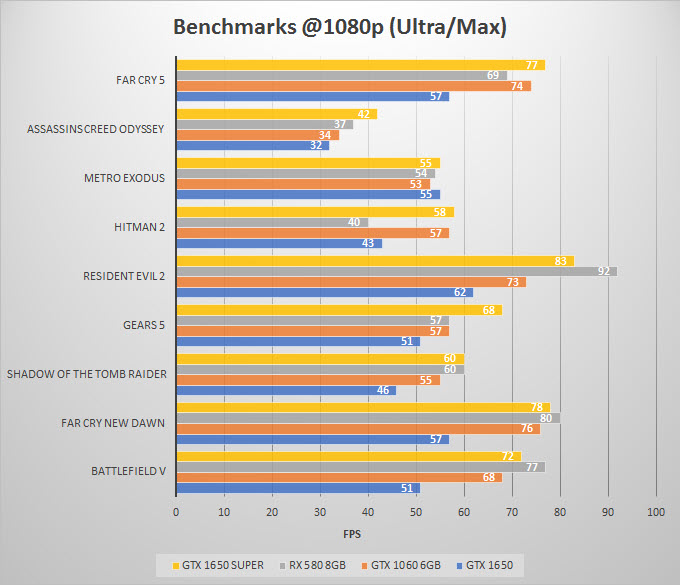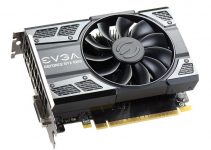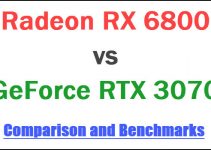The launch of GeForce GTX 1650 SUPER has created a tremor in the budget graphics card category. In fact, it has also given some mainstream graphics cards a run for their money, which are basically one segment above it. The main competitor of GTX 1650 SUPER is Radeon RX 580, which is a very good value-for-money graphics card. Also, GTX 1650 SUPER competes against its younger sibling GTX 1650 and the older GTX 1060 6GB, which was one of the best mainstream graphics cards a couple of years back. So, if you want to know how the newer GTX 1650 SUPER fairs against its competitors in different areas then just keep reading because here you will know it all.

GTX 1650 SUPER vs RX 580 vs GTX 1060 vs GTX 1650
Here is a comparison between these cards based on their specifications, performance, features, power consumption, and pricing.
GPU Architecture
GTX 1650 and GTX 1650 SUPER are GeForce 16 series cards from Nvidia that are based on the Turing GPU architecture and are built on the 12nm manufacturing process. GTX 1650 comes with 896 CUDA Cores and uses a TU117 GPU chip, while the GTX 1650 SUPER comes with 1280 CUDA Cores, which is 384 CUDA Cores more than the GTX 1650 and uses the TU116 core, which is the same GPU Chip used in the GTX 1660 and GTX 1660 Ti but with more CUDA Cores unlocked.
GTX 1060 is an older GeForce 10 series card that is built on the Pascal GPU architecture with a 16nm process and comes with 1280 CUDA Cores (6GB version). Both GTX 1650 SUPER and GTX 1060 do contain the same amount of CUDA Cores, but due to their different architectures, their performance differs in the games. On the other hand. Radeon RX 580 is an AMD graphics card built on the Polaris GPU architecture on the 14nm FinFET process and comes with 2304 Stream Processors.
Must Read: CUDA Cores vs Stream Processors Difference
| GTX 1650 | GTX 1650 SUPER | GTX 1060 6GB | RX 580 | |
| GPU Chip | TU117 | TU116 | GP106 | Polaris 20 |
| Manufacturing Process | 12nm | 12nm | 16nm | 14nm |
| CUDA Cores / Stream Processors | 896 CUDA Cores | 1280 CUDA Cores | 1280 CUDA Cores | 2304 Stream Processors |
| GPU Architecture | Turing | Turing | Pascal | Polaris |
Memory [VRAM]
Both GTX 1650 and GTX 1650 SUPER come with 4GB video memory, but they differ in memory type and configuration. GTX 1650 comes with GDDR5 memory that is 128-bit wide and runs at 8Gbps while GTX 1650 SUPER is equipped with faster GDDR6 memory, having a 192-bit interface and runs at a much higher speed of 12Gbps. Radeon RX 580 comes in both 4GB and 8GB GDDR5 variants but offers the highest memory bandwidth of all because of its wider 256-bit memory bus. GTX 1060 comes in both 3GB and 6GB GDDR5 versions, having a memory bus width of 192-bit and offers bandwidth equal to that of the GTX 1650 SUPER, which is 192 GB/s. Clearly, the 8GB version of RX 580 wins here because of more video memory and higher memory bandwidth.
Must Read: GDDR5 vs GDDR6 vs HBM2 Memory Difference
| GTX 1650 | GTX 1650 SUPER | GTX 1060 6GB | RX 580 | |
| Memory Size | 4GB GDDR5 | 4GB GDDR6 | 6GB GDDR5 | 4GB / 8GB GDDR5 |
| Memory Interface | 128-bit | 128-bit | 192-bit | 256-bit |
| Memory Speed | 8 Gbps | 12 Gbps | 8 Gbps | 8 Gbps |
| Memory Bandwidth | 128 GB/s | 192 GB/s | 192 GB/s | 256 GB/s |
Features
All these cards come with all the essential modern-day gaming features such as FreeSync / G-Sync and support the latest graphics APIs that include DirectX 12, OpenGL 4.6 and Vulkan. Only the GTX 1650 is not a VR Ready card, but others are. All of the cards here support hardware-based encoding and decoding. The GTX 1650 comes with Volta NVIDIA Encoder (NVENC) while the GTX 1650 SUPER comes with the latest Turing NVIDIA Encoder (NVENC). Here, the only card that supports multi-GPU configuration is the Radeon RX 580 which includes CrossFire support.
| GTX 1650 | GTX 1650 SUPER | GTX 1060 6GB | RX 580 | |
| DirectX | 12 | 12 | 12 | 12 |
| OpenGL | 4.6 | 4.6 | 4.6 | 4.6 |
| Vulkan API | Yes | Yes | Yes | Yes |
| SLI / CrossFire | NA | NA | NA | CrossFire |
| VR Ready | No | Yes | Yes | Yes |
| G-Sync / FreeSync | G-Sync / FreeSync | G-Sync / FreeSync | G-Sync / FreeSync | FreeSync |
Gaming Performance
Here are some gaming benchmarks of these cards at 1080p in the latest and popular AAA titles.

From the above benchmarks, you can clearly see that GTX 1650 SUPER is up to 40% faster than the GTX 1650 and performs similar to RX 580. In most of the games, it remains ahead of the RX 580 while in some games it does lag by a little margin. The card beats GTX 1060 6GB in almost every game but not by a significant margin.
Power Consumption
When it comes to power consumption then GTX 1650 consumes the least amount of power. It has a power consumption of 75W and some of the GTX 1650 cards don’t even require a supplementary 6-pin PCI-E connector for power as they can draw all the needed power from the PCIe x16 slot only. The card that consumes slightly more power than GTX 1650 is the GTX 1650 SUPER which has a maximum power draw of 100W and it does require a 6-pin PCIe power connector from the PSU. The card that consumes the maximum amount of power is the RX 580 with a rated power consumption figure of 185W and it requires an 8-pin PCIe connector and a 500 Watt PSU for its working. The power consumption of GTX 1060 6GB remains at 120W and it requires a 400W PSU for its operation.
| GTX 1650 | GTX 1650 SUPER | GTX 1060 6GB | RX 580 | |
| Power Consumption | 75W | 100W | 120W | 185W |
| Recommended PSU | 300W | 350W | 400W | 500W |
Pricing & Availability
The least expensive card here is the GTX 1650 that has base MSRP of $150, while the GTX 1650 SUPER costs only a mere $10 more than it at $160. GTX 1060 6GB is no longer in production and was priced at $300 when it was launched. However, you can now have it at around $200 which is still not reasonable for such an old card. The 8GB version of RX 580 can be had for $180 to $200 depending on the model and manufacturer. You can check the current pricing of all these cards from the links given below.
Check GTX 1650 SUPER Price on Amazon
Check GTX 1650 Price on Amazon
Check GTX 1060 6GB Price on Amazon
Check Radeon RX 580 Price on Amazon
GTX 1650 SUPER vs RX 580 vs GTX 1060 vs GTX 1650 Specifications
| GTX 1650 | GTX 1650 SUPER | GTX 1060 6GB | RX 580 | |
| GPU Chip | TU117 | TU116 | GP106 | Polaris 20 |
| CUDA Cores / Stream Processors | 896 CUDA Cores | 1280 CUDA Cores | 1280 CUDA Cores | 2304 Stream Processors |
| GPU Architecture | Turing | Turing | Pascal | Polaris |
| Memory Size | 4GB GDDR5 | 4GB GDDR6 | 6GB GDDR5 | 4GB / 8GB GDDR5 |
| Memory Interface | 128-bit | 128-bit | 192-bit | 256-bit |
| Memory Speed | 8 Gbps | 12 Gbps | 8 Gbps | 8 Gbps |
| Memory Bandwidth | 128 GB/s | 192 GB/s | 192 GB/s | 256 GB/s |
| Bus Interface | PCI Express 3.0 | PCI Express 3.0 | PCI Express 3.0 | PCI Express 3.0 |
| DirectX | 12 | 12 | 12 | 12 |
| OpenGL | 4.6 | 4.6 | 4.6 | 4.6 |
| Vulkan API | Yes | Yes | Yes | Yes |
| SLI / CrossFire | NA | NA | NA | CrossFire |
| VR Ready | No | Yes | Yes | Yes |
| G-Sync / FreeSync | G-Sync / FreeSync | G-Sync / FreeSync | G-Sync / FreeSync | FreeSync |
| Power Consumption | 75W | 100W | 120W | 185W |
| Recommended PSU | 300W | 350W | 400W | 500W |
Read also:
- GTX 1660 SUPER vs GTX 1660 Ti vs GTX 1660 vs RX 590 Comparison
- RX 5500 XT vs GTX 1650 SUPER vs RX 580 vs GTX 1660 Comparison
Final Thoughts
The clear winner here is the GTX 1650 SUPER because of its attractive pricing, superb performance, and lower power consumption. The card costs slightly more than GTX 1650 but delivers way more performance over it. It beats GTX 1060 6GB completely and also stays ahead of Radeon RX 580 in most of the games and that too with consuming way less power (almost half of RX 580). The only thing that goes slightly against this card is that it only has 4GB video memory, which is enough for 1080p gaming but not for 1440p. However, the card is mainly targeted toward budget gamers who play at 1080p resolution only, and for them, this card is more than sufficient. If you have any queries regarding these graphics cards or graphics cards in general, then please ask them in the comment section below.
(*This post may contain affiliate links, which means I may receive a small commission if you choose to purchase through the links I provide (at no extra cost to you). Thank you for supporting the work I put into this site!)



Do you think gtx 1650 super will make a good performance in at least 2 years? Thank you
I think it will age well.
Do yo think It does not be a problem the 4Gb VRAM in the future for next games like Red Dead Redemption 2, Call of Duty Modern Warfare, Ciberpunk 2077, Control, etc???????????
It can be a problem with some heavy graphics intensive AAA games like Red Dead Redemption 2 but for rest it will be enough at 1080p.
Great article.Thank you and keep up with good work!
Thanks for the appreciation.
I plan to build a PC with AMD 3900x for Photoshop and Premiere Pro only. My main concern is to achieve reasonable playback speeds in Premiere Pro with multi camera view (using 1/4 playback resolution and upto 6 cameras some in 1080p some in 4K)
Would 1650 Super be a good enough? Or should I push for 1660 Super? What would your recommendation be for a GPU at those price ranges?
Better go with the GTX 1660 SUPER.